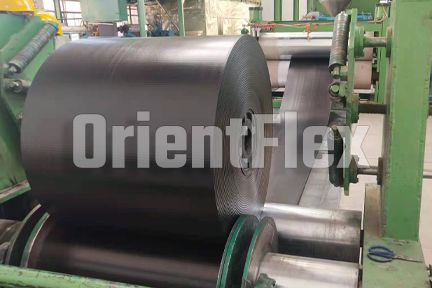- Email orientflex@orientrubber.com
- WhatsApp / Phone+86 180 3186 9514
The rollers are usually made of seamless steel pipes, and depending on the needs of different processes, such as aluminum alloy 6061T5, 304L/316L stainless steel, 2205 duplex stainless steel, steel castings, and solid forged alloy steel cores are used as materials.
1. The roller should have sufficient rigidity to ensure that the bending deformation does not exceed the allowable value under heavy load.
2. The surface of the roller should have sufficient hardness, which is generally required to reach HRC50 degrees or more, with strong corrosion resistance. The coating has an anti-stripping ability to ensure that the working surface of the roller has good wear resistance and corrosion resistance.
3. The working surface of the roller should be finely processed to ensure dimensional accuracy and surface roughness. The roughness should be above Ra0.16, without pores or grooves. The wall thickness of the working surface of the roller must be uniform, otherwise, the temperature of the roller surface will be uneven and the product quality will be affected.
4. The material of the roller should have good thermal conductivity. Chilled cast iron is usually used, and cast steel or molybdenum-chromium alloy steel is used in special cases. Whether it is heating or cooling, it can achieve rapid and uniformity.
The production of rollers mainly consists of the initial turning of the roller body, initial static balancing, shaft end interference assembly welding, fine turning, and fine dynamic balancing. If the geometric tolerances such as roundness, cylindricity, and straightness are required to be less than 0.2mm, they need to be ground on a cylindrical grinder or roll grinder after finishing. If surface hardness is required, it is necessary to increase the heat treatment process.
After the roller is formed, to prevent rust and corrosion, wear resistance, and support, it also needs surface treatment or coating such as painting, galvanizing, TEFLON spraying, rubber coating, chrome plating, ceramic spraying, and oxidation.
Classified by size, there are large rollers such as paper machine rollers (the length can reach more than 10 meters, the diameter is more than 1500mm), and there are small ones such as flat rollers used for belt conveyors on automatic assembly lines (usually within 1 meter in length). , The diameter is also within 159mm).
According to the function, some rollers need to ensure transmission accuracies, such as the roller on the digital laser printer, the pressure filter, such as the calender roller on the papermaking machine, and the supporting roller that does not require high dimensional accuracy. The rollers required for exchange also include rollers for heavy-duty filter presses.
To prolong the service life of the roller, the maintenance work of the roller must be done well.
1. Regularly clean the dust and other foreign objects on the roller.
2. Regularly check whether the welding place between the drum shell and the end cover is firm.
3. Good lubrication, reducing wear loss.
3. Avoid overload operation and prolong the service life of the roller.
You can contact or visit us in our office from Monday to Friday from 8:00 - 18:00





